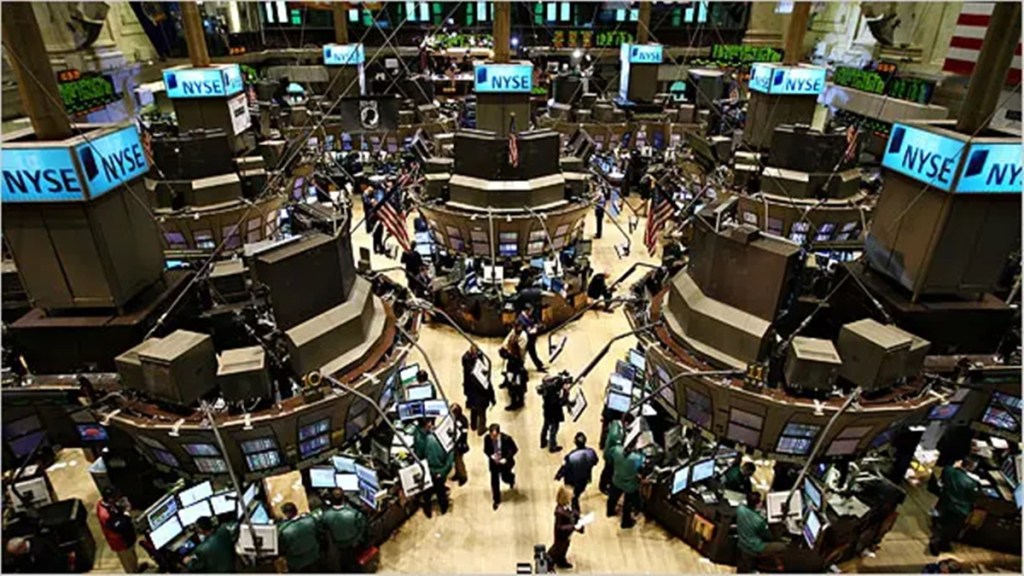US stock futures fell on Monday as investors braced for a week full of crucial economic data and large corporate reports. GIFT Nifty was in green and up by about 86 points on Monday.
On the economic front, the focus will be on Tuesday’s producer inflation figures and Wednesday’s consumer inflation data, as well as crucial comments from Federal Reserve officials.
With major banks like Citigroup, Goldman Sachs, JPMorgan Chase, Morgan Stanley, and Bank of America reporting this week, corporate earnings are also a focus.
The S&P 500 fell 1.54% on Friday, while the Dow and Nasdaq Composite fell 1.63%. These losses came after a strong jobs report that tempered expectations that the Fed would slash interest rates further this year.
The central bank is expected to maintain rates at its next sessions in January and March, according to market forecasts.
After increasing 17 basis points last week, the yield on the US 10-year Treasury note approached 4.8% to begin the second week of the year, reaching its highest level since October 2023. In a similar vein, for the first time in more than a year, the yield on the 30-year Treasury exceeded 5%.
A stronger-than-expected jobs report on Friday caused traders to lower their expectations for rate reduction by the Federal Reserve this year, which put pressure on market mood.
As further US sanctions on Russia’s energy sector sparked worries about supply disruptions, WTI crude oil futures jumped more than 2% to beyond $78 per barrel on Monday, the highest level in over four months. The most extensive sanctions to date targeted over 150 tankers, major exporters, and insurers, forcing important consumers like China and India to look for other options.
With Indian refiners bracing for months of possible interruption and Chinese refiners holding emergency meetings, the decision has already created confusion.
The BSI Sensex dropped even more, closing Monday at 76,330, down roughly 1.4%, its lowest level since June 2024 and the fourth consecutive session of falls.
The market mood was nevertheless impacted by expectations of fewer rate cuts from the Fed, unchecked foreign outflows, worry about slower corporate profitability and concerns about weaker domestic growth. Broad-based selling occurred in the domestic market, with Zomato leading the declines at 6.5 percent, followed by Power Grid Corporation and Adani Ports at 4.1 percent. Particular attention was paid to the December inflation data on the domestic front since it provided information on the possible course of the RBI’s interest rate policy.
The Indian rupee fell to more than 86.6 per USD in January, the lowest level on record, as rising capital outflows, reduced foreign exchange reserves, and the prospect of looser monetary policy put pressure on the rupee’s crawling peg.
Evidence of a dramatic slowdown in India’s economic growth defied previous expectations that it would outperform other emerging nations, prompting investors to exit Indian capital markets and shift to competing Asian assets.
This was magnified by expectations that the RBI is due to commence its cutting cycle before the end of the financial year amid lower inflation and a sharp drop in GDP growth.
The latest data indicated that inflation slowed to 5.2% in December, and the preliminary FY2025 GDP slowed to 6.4%, the lowest since FY2020 when excluding pandemic shocks. To add, the rapid deterioration in foreign exchange reserves raised speculation that the RBI may be forced to start relaxing its support for the currency.
The dollar index topped 110 on Monday, the highest level since October 2022, and extending a 0.6% gain in the first week of the year, as traders scaled back expectations for Federal Reserve rate cuts this year, driven by a stronger-than-expected jobs report on Friday.
Concerns over inflationary policies under President-elect Donald Trump also added to the cautious outlook. Traders now anticipate only 27 basis points of rate cuts in 2024, a sharp reduction from the 50 basis points forecast earlier this month, with the expected single quarter-point cut likely postponed to the second half of the year.
This week’s CPI and PPI data will offer key insights into inflation trends. The dollar strengthened across the board but the biggest gains were seen against the British pound and the Euro.

